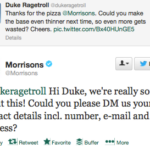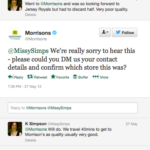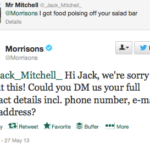As I was sifting through the data that Bizbuzz was providing about potential ServiceChat customers, I came across Morrisons – a British grocery and supermarket business that has about 12% of the UK grocery market (source: Economics Help)
I was looking at their ‘apology’ buzz – a tracking of how many apologies they are making to customers and that would lead me to who they were apologising to – an unhappy customer with some feedback dressed as a complaint.
The date was May 27th and as I scanned the apologies, I picked one at random to see the details of the apology – what triggered it and perhaps, any further conversations in the thread. The apology I picked related to Ian Golding’s tweet.
I read Ian’s profile and reached out to him to seek more context about the events that led to his experience. Learning more about Ian revealed that he is an active blogger and a passionate customer experience specialist, striving to help businesses delight their customers – my kind of guy!
Ian had written fairly extensively about his Morrisons’ experience and after I read it I wondered whether Morrisons’ level of engagement and the resolution they demonstrated in Ian’s experience was typical and part of a designed approach to delighting customers, or was it simply a fluke. After all, I knew from my data that on May 27th – the day of Ian’s experience – there were 12 other customers who sent Morrisons a variety of feedback via Twitter.
What were their experiences of Morrisons’ engagement with them about their feedback?
How many felt they got a satisfactory resolution from calling Morrisons’ attention to something they perceived needed improvement in a store, with pricing, product quality and/or staff behaviour?
Some Immediate Observations
Morrisons uses auto-responders
As I was looking through the content it became obvious that Morrisons’ responses are a template and most likely a template used by an auto-responder. They appear to be semi-customised templates where they try and get the first name of the account that sent the tweet they are responding to and use it to personalise the reply.
They clearly also have responses they either cycle through so they are no so obviously simply auto responding.
All responses are redirection
All the responses I saw for this date (May 27th) and the other 180 apologies in Morrisons’ buzz are all asking the other person to DM their phone number and email to the Morrison account. I imagine this is to put it on a queue for their customer service desk to deal with.
I did not observe any attempt to address the feedback directly online. The DM leads potentially to some further engagement offline – via a phone call or email. This was borne out in Ian’s case and caused me to wonder – What do Morrisons’ customer think of this lack of readiness to engage completely online.
Morrisons is not being social on social media
A quick snapshot of Morrisons’ activities on Twitter show an account that is not about engagement (contrast this with @Waitrose). It is almost exclusively about pushing offers, tips and other canned responses out there (pardon the pun!). There is no seeking engagement nor responding to any tweets coming back in. They are missing a great opportunity to build rapport with their customers and do the other canned stuff in a way that would improve their their brand perception.

What About the Other Customers?
I approached the other twelve customers to whom Morrisons had auto-apologised on May 27th on Twitter, asking for their input in answering the above questions.
The responses were mixed. Five of the 12 other customers responded to my invitation. Their experiences were sometimes quite starkly different. Some didn’t get any further contact despite sending a DM replying and others got a mixed resolution from the extended engagement.
@missySimps replied to the auto-apology as a DM. She didn’t have any further engagement from Morrisons nor any resolution to the situation.
@tracySmith2k, @jakimccarthy, @pauldavid28 and @captainratall got a reply to their DM and a call. But their experience were also fairly different:
@tracySmith2k was uncomfortable with the call she received from the store manager – she felt it was confrontational- and would have preferred it was handled by an objective intermediary.
@jakimccarthy got to speak with the store manager who explained the situation to her and apologised again. She doesn’t know if they did anything to rectify the dirty fridges she complained about, but she felt heard and the experience has not put her off from shopping at Morrisons.
@pauldavid28 – was pretty pleased with how it was handled, how Morrisons engaged with him and how his query was finally resolved. Awesome!
@captainrat – got a call, had the issue resolved and even got a token of their apology. Great outcome!
What Does It All Mean?
Let’s do the math. We now know how 6 of the apologies that Morrisons made on May 27th turned out.
75% were happy with the level of engagement
50% had a resolution they were satisfied with
10% had no further engagement beyond the auto-apology.
I think Morrisons do have a desire to engage with their customers on social media. I also think there is a strategy to genuinely engage and resolve customers queries that are received from social media platforms, in this case Twitter. From the interactions I have had with their customers, they seem to understand the value of engagement, even if currently it is mostly about handling it offline.
They may be being a little cautious online and currently don’t do anymore than auto-respond. For example, their activity on twitter smacks of auto-everything. There don’t seem to be any humans at home, which is very strange for a social platform.
Clearly, in the instances where they engage with customers, they try and get the ‘right’ person to engage with the customer. In the cases I explored, it was almost always the store manager.
This is good – let the person who can do something about the issue deal with it. In only one instance did I find that this wasn’t satisfactory.
I must confess, I am disappointed with the whole auto-responding aspect of Morrisons’ social media operation – at least on Twitter (I didn’t do any Facebook exploration).
I am especially disappointed with their auto-apologising. An apology is supposed to be sincere and human. I think automating an apology – especially one in response to a complaint – cheapens it. Not such an issue if you almost immediately follow it with human engagement – like a phone call – where you can have the conversation.
But if, as in the case of @missySimps, all that was experienced was a nondescript, auto-reply – even one faked out with personalisation – it can feel insincere.
Making people think they got contacted by a human when it was just a program is pretty ‘Matrix’. Difference is ‘Matrix’ was cool and this isn’t.
Auto-responding communicates to me that they don’t really understand the power of social media or are being advised by people who don’t really understand the power of social media!
3 Things Morrisons Can Do To Improve
I’m all about improving and this post is primarily about giving Morrisons some feedback to sweeten its social media operation and let it complement the great work they are already designed to do with store manager calls etc.
So here goes, my top 3 things Morrisons can do better at:
- Lose the auto-responders and put humans on the social media desk. With the low volumes of social interaction you currently have, you might not even have to hire more people right now. You can get software to route tweets to your customer service folk. But you must make sure they know how to use social media. Social is entirely about being human.
Something you can do right now, Morrisons, might be to completely de-personalise the auto replies, make them authentically robotic. For example, ditch the first name thing and reply with ‘We aren’t here right now, we auto followed you, so please DM us…’, then route them to the store manager and work your magic. First names are for humans to speak to humans. - Get tools that promote and facilitate online engagement. People chose to engage with you online, redirecting them to some offline mechanism might suit you but it usually just frustrates them. Oh, and shun those tools that promise to help you deal with scale. The scaling problem comes later. Focus on getting great with online engagement then fix the scaling problem. From a quick search on Twitter, @Morrisons gets about 10 mentions a day, most are not about them per se. And their bizbuzz page shows they are apologising an average of 3 times a day. This is the time to get in and get good with this exciting world of social media.
- Be open about your journey in trying to delight your customers on social media. There is a growing generation that will love you for it. You might be thinking “we sell groceries, we don’t need social media”. Everyone is going to need social media. Your competitors are embracing it and once they are fully established in it, it will be almost impossible to wean customers off them.
Thanks!
I am deeply grateful to @missySimps, @tracysmith2k, @jakimmcarthy, @captainrat and @pauldavid28 for responding to my tweet and being so generous with their time to listen and engage with me on this topic. It helps to continually renew my faith that people want to be connected, be heard and to engage. Thank you.
This post is also guest posted on Ian Golding’s very informative blog. Go check it out.



















Leave a Reply